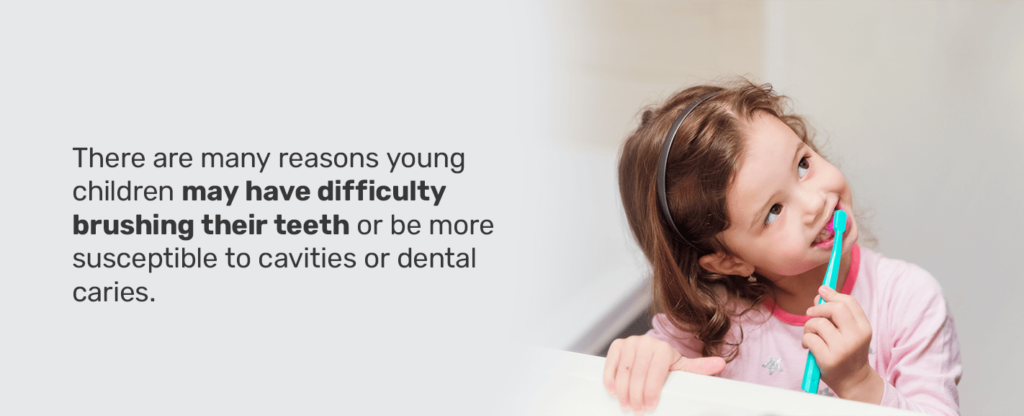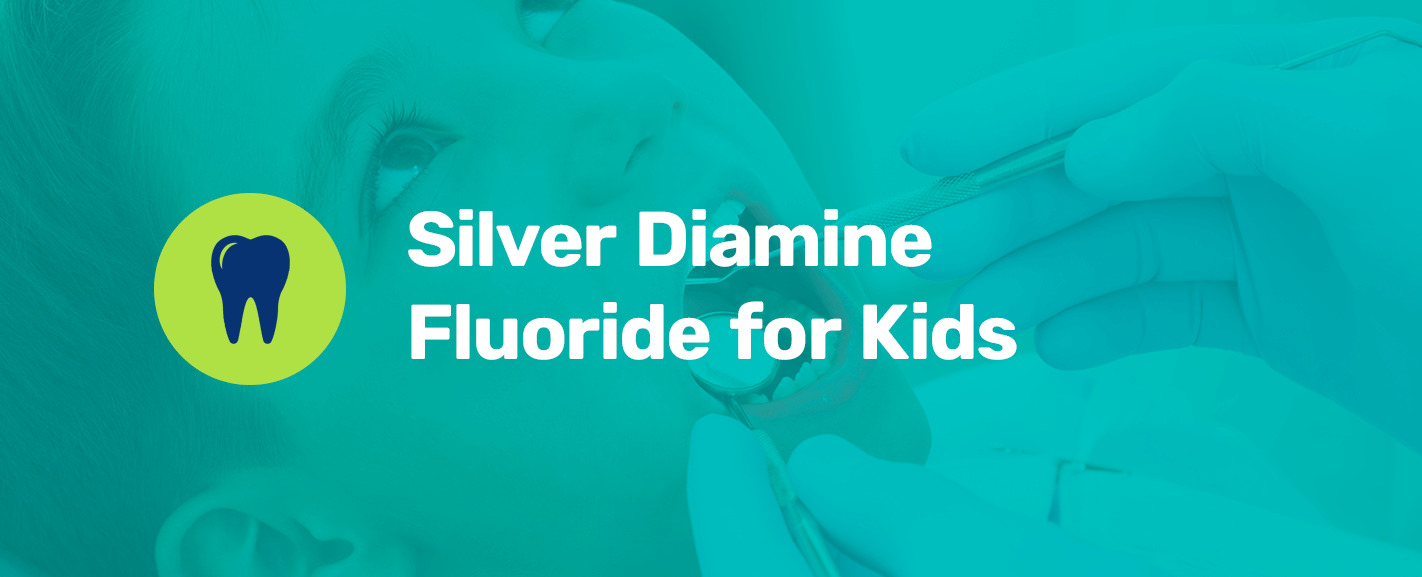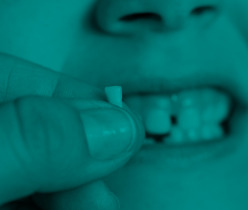Silver Diamine Fluoride for Kids
When it comes to your child’s dental health, drilling and filling cavities is a process most parents and kids want to avoid. Now there’s an alternative that many parents and dentists are opting for to treat tooth decay in kids — silver diamine fluoride. As with any emerging type of treatment, there are questions and concerns about silver diamine fluoride. Understanding more about this non-invasive intervention is the first step to evaluating whether it’s right for your child’s teeth.
How SDF Works? | Are there risks to SDF? | How is SDF applied? | When do dentists recommend SDF? | SDF vs. Drilling and Filling | Is SDF right for my child?
What Is Silver Diamine Fluoride?
Silver diamine fluoride (SDF) is a liquid topical solution, meaning it is applied to the outside of the teeth. A dentist will use a small brush or a special type of floss to apply it to the affected areas. The silver fluoride formula is 38% silver fluoride salt, which is made water-soluble by the addition of small amounts of ammonia. The Fluoride in this solution strengthens and protects the enamel layer in your child’s teeth, and silver is effective at treating decay and preventing further deterioration.
The result is a liquid that dentists can easily paint onto teeth in a matter of seconds! SDF helps kill bacteria, so it’s a very effective treatment for cavities in young children. However, dentists generally only use SDF on baby teeth because it dyes the affected part of the tooth a black or dark brown color.
SDF has been used extensively around the world for decades, although it only received approval from the Food and Drug Administration (FDA) in 2014. The FDA actually approved SDF for use in the treatment of dentin sensitivity. For dentists to use it as a way to treat cavities means that, as with its predecessor fluoride varnish, dentists using SDF to treat cavities are doing so “off-label.”
How Does SDF Work?
SDF works because silver and fluoride are able to stop or limit dental decay. Silver’s antibacterial properties have been known for centuries, and its low toxicity makes it ideal for use in humans. Fluoride is a mineral that comes from rocks, and most bodies of water have small levels of fluoride in them naturally, though some municipalities add more of this mineral as a public health measure.
Fluoride treatment significantly increases the rate at which tooth enamel can be remineralized by saliva, and at the same time, increases the enamel’s resistance to harmful acids. Fluoride has antimicrobial properties as well, killing bacteria in the mouth that cause cavities.
SDF prevents tooth decay and stabilizes the tooth until a dentist can evaluate if they need to perform further treatments. SDF also helps harden the tooth structure softened by decay.
Benefits of SDF

Dentists use SDF because it has many benefits for children’s teeth development. There are many reasons young children may have difficulty brushing their teeth or be more susceptible to cavities or dental caries. Some of the benefits of SDF for children include:
- Non-invasive: Because SDF is a topical solution applied to the outside of a child’s teeth, it is a great alternative treatment to fillings and other cavity treatments. It is an especially good solution for young children, as the sound or drills and the experience of filling cavities can lead to fear, or more severe reactions, like dentophobia.
- Safe: SDF has no reported health risks or reactions, so it’s a safe alternative to filling cavities in baby teeth. Since the dentist will paint SDF on the teeth, it’s also safer for children who might have trouble remaining still and calm in the exam chair.
- Cost-effective: Filling a cavity can be an expensive treatment option, but SDF usually comes out at much lower costs. While it does result in some cosmetic alterations to the tooth, it’s a fantastic, approachable treatment option for a variety of budgets.
- Quick: Getting kids into the dentist can be stressful for both them and their parents. SDF is a quick treatment option for cavities, making it an especially attractive treatment for families with young children.
Are There Risks or Side Effects to SDF?
SDF carries very few risks, but some potential side effects of SDF treatments include:
- Tooth staining: When the silver in SDF is applied to a tooth, it oxidizes and leaves a black stain on the damaged cavity portion of the tooth. However, it does not stain healthy surface enamel. The blackening is permanent on the teeth, however, which may be enough to deter adults from choosing this form of treatment for their own cavities. For children with baby teeth, however, the stains are temporary because the teeth will fall out on their own. Even so, some parents opt to hide the staining with crowns, which is why some kids have silver teeth.
- Tissue staining: It can also temporarily stain surfaces like lips and gums. For gums and tissue in the mouth, the staining is temporary, as the old cells will eventually replace themselves with new tissue. Stains may persist for a few days up to a couple of weeks. When applied by a skilled dentist, the chances of tissue staining are fairly low.
- Contact irritation: There is a chance that SDF that comes in contact with oral tissues will cause some irritation, but this is quite mild as well as temporary. It may also impact or irritate those with ulcers, so it may not be a great option if your child tends to get ulcers in their mouth.
- Silver allergies: Since SDF contains silver, it should not be used on patients who have a silver allergy.
Other than these potential side effects, silver diamine fluoride safety is a key part of the treatment’s appeal.
How Is SDF Applied?
The actual application of SDF is incredibly quick and painless. While a universally-recognized process for applying SDF has not been developed, the simplicity of the procedure means that most dentists follow the steps recommended in the Chairside Guide by the American Academy of Pediatric Dentistry (AAPD) when performing SDF dental treatment.
1. Cleaning the Area
All dental procedures need a clean mouth to be safe and effective. SDF is no different. The dentist will remove any debris from the tooth’s cavitation to ensure the solution makes the best possible contact with the affected area. This includes plaque, food debris and possibly even some of the cavity.
2. Isolating the Area
Since there is a possibility of staining to the lips and skin, Vaseline can help protect and prevent SDF from impacting surrounding areas. Dentists will also isolate the treatment area using cotton rolls or other methods. The gums are usually protected with petroleum jelly or cocoa butter.
3. Applying the SDF
When the mouth is properly prepped, it’s time for the dentist to dry the tooth with compressed air or dry gauze and apply the SDF with a microbrush. They simply dip the brush into the solution, remove any excess liquid and paint the SDF directly on the affected surface. A single drop of the solution is enough to treat up to eight teeth at once.
The application itself takes about a minute but can be shorter for young patients who may be less able to keep still for sustained periods. To allow the SDF to set, the dentist will dry it with a gentle stream of air. Optimally, the affected teeth are then covered with a fluoride varnish which acts as a top coat and seals in the SDF over the cavity portion of the tooth.
Follow-Up
Patients should follow up with their dentist two to four weeks after the initial treatment to make sure the SDF is doing its job. Many people see their cavities arrested with just one treatment. According to the Chairside Guide, estimates of SDF treatment effectiveness range between 47 and 90% for a single application. If a single treatment doesn’t fully stop the cavity from growing, a dentist may recommend further applications.
When and Why Do Dentists Recommend SDF?
There are many reasons SDF treatment is a good choice. Many of them have to do with the treatment’s low financial impact. While drilling and filling a cavity can cost a couple of hundred dollars on average, treatment with silver diamine fluoride will usually cost less than $100 out of pocket and may even be covered by your insurance! Its affordability makes SDF a great option for people on strict budgets or who have trouble finding or accessing dental care.
Schedule an Appointment with Dr. Fox
In particular, SDF is a promising cavity treatment for children. Because their teeth aren’t yet permanent, the aesthetic issue of staining is far outweighed by the benefits of getting cavities treated. SDF is also a highly effective preventive measure that may stop teeth from decaying in the first place. This form of treatment is growing in popularity as a pediatric dental treatment.
The Problem of Kids and Cavities
Cavities are alarmingly common in children. Data from the AAPD’s The State of Little Teeth report shows the problem is substantial:
- While rates have dropped in recent years, nearly one in five children under the age of 5 have experienced dental decay.
- Nearly half of children aged 6-11 have tooth decay.
- More than 50% of children aged 12-19 experience issues with tooth decay.
- Children living in poverty are more than twice as likely to suffer from untreated dental decay than their peers.
Underestimating the danger of cavities in childhood can lead parents not to seek treatment. Tooth decay can have many negative consequences for the health and development of children, impacting eating habits, self-esteem, sleep, speech and school performance.
The impacts of cavities on kids are both short-term and far-reaching, even when it’s only baby teeth that are affected. Some of the short-term issues include:
- Significant pain
- Chewing difficulty
- Poor speech articulation
- Poor sleep habits
- Lowered self-esteem
- Poor school performance
Cavities can even increase the chances of a child getting an infection in a different part of the body, like the ears and sinuses. If left untreated, cavities can lead to infections that damage emerging permanent teeth. Cavities in kids now make it more likely for the child to suffer poorer dental health effects later.
Since prevention is the most ideal treatment option, there are a few things parents can do to significantly reduce their child’s chances of developing cavities. For example, children who drink fluoridated tap water tend to have fewer cavities, as well as those who brush daily with fluoride toothpaste.
SDF vs. Drilling vs. Filling
Silver diamine fluoride treatment is one of the best alternatives to filling cavities in baby teeth. Of all the options for treating cavities and tooth decay in toddlers and children, SDF is the least invasive. Consider the alternative — classic fillings. The process requires around an hour at the dentist’s office. The dentist first numbs the teeth, gums, and skin surrounding the mouth to prevent pain during the procedure. The dentist then drills the decay out of the affected teeth and replaces it with a dental paste for cavities made of silver amalgam, composite resin or other materials.
While the process of getting a filling is relatively short, it can be a scary ordeal for a child. The sound of the drill in combination with the strange sensation of mouth-numbing can throw kids into a panic. Because the drilling process must be precise, especially when handling smaller teeth, there is a certain level of cooperation that must be met in order to do fillings on young children.
The complete filling procedure can be stressful, but it’s necessary to restore teeth in the long term. If the affected teeth are baby teeth, however, it may not be worth it to restore them. SDF works as an alternative cavity treatment by stopping tooth decay from getting worse. It doesn’t restore the teeth — it works as a stop-gap solution while you’re waiting for baby teeth to fall out.
Is Silver Diamine Fluoride Treatment Right for My Child?
As a parent, you likely have more questions about silver treatment for cavities and wonder if it really is right for your child. Here are some of the specific situations in which SDF makes the ideal child tooth cavity treatment:
- Babies and toddlers: Many parents aren’t sure about baby tooth decay treatment and don’t know how to treat cavities in toddlers. Their teeth are tiny, they don’t hold still and the younger the child, the greater the risk associated with sedation. SDF can keep teeth from decaying further until they fall out.
- Multiple cavities: When a child has a significant number of cavities, the filling process only becomes longer and leads to more discomfort after the fact. Since an SDF treatment can cover up to about eight teeth at once, it’s an effective solution for children with several affected teeth.
- Special needs: Children of all ages with special needs may not have the ability to restrict their own movement enough to receive numbing or know that they need to remain still and calm for the procedure. SDF can treat their cavities in just minutes, without causing undue distress.
- Older kids: Baby teeth don’t fall out all at once, and kids up to age 12 or 13 may be dealing with tooth decay in baby teeth as their permanent teeth come in. With a skilled application, SDF can keep decaying baby teeth from negatively impacting surrounding permanent teeth as they emerge and develop.
- Genetic predisposition: If you have a family history of cavities, it’s wise to use SDF to lower your child’s risk of developing them. The internationally-recognized safety of silver diamine fluoride makes it an excellent tool for preventing cavities, not just treating them after they have occurred.
Overall, SDF is a highly effective child tooth decay treatment option for infants all the way through the loss of the last baby tooth. It also gives a boost to the health of permanent teeth and can set your child up for better dental health throughout their lifetime. With the low cost and minimal downtime, SDF is a powerful solution in almost any scenario where baby teeth are decaying or at risk of decay. There are, however, a few situations where SDF is not recommended. Patients who shouldn’t undergo SDF include:
- Those who are allergic to silver.
- Those who have an oral ulcerative condition, such as lichen planus or gingivitis.
- Those who have significant damage to front teeth or who don’t want to have stained teeth at all.
For many parents who consider SDF for kids, the biggest worry is how the black staining will affect their child’s smile. It’s important to remember that the extent of the staining is tied to the extent of the tooth decay. If the damage is extensive enough that using SDF would create a large area of black, the pediatric dentist may recommend removing the tooth instead. SDF is usually only recommended in cases where the extent of tooth decay will not result in an excessive blackening of the teeth.
Talk With Your Pediatric Dentist About SDF
Ultimately, the only way to determine whether silver diamine fluoride treatment is right for your child is to ask your pediatric dentist about it. Not every dental practice offers this form of treatment, and it’s important to choose a dental team that’s trained and knowledgeable about this relatively new solution.
If you’re looking for quality dental care and SDF treatment for your child in Portland, you’ll find the best of the best at Sprout Pediatric Dentistry. Our dental team is well-versed in every recognized treatment and prevention program for cavities. In Oregon, dental hygienists and dentists can apply an SDF treatment so your child can receive effective treatment with little waiting time.
We invite you to learn more about what sets Sprout Pediatric Dentistry apart by requesting an appointment. Based on the information you share about your child and their current needs, we’re happy to answer any and all questions you have about silver diamine fluoride and other pediatric dental treatments.

Dr. Dana grew up in Portland and went to Temple University in Philadelphia, PA for dental school. She then moved to Anchorage, AK for her residency in Pediatric Dentistry. Dr. Dana takes a holistic approach to pediatric dentistry & is able to use her own parenting experience to sympathize and understand each family’s unique dynamic.




